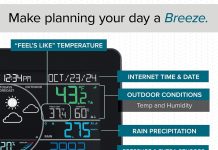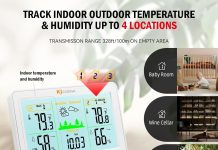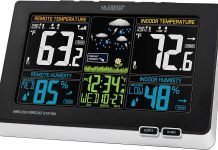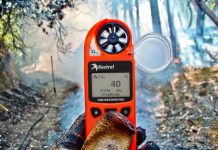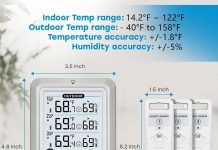Curious about the wonders of weather? Look no further than your own backyard! A home weather station is the perfect tool to explore the ins and outs of Mother Nature’s moods. From tracking temperature changes to learning about atmospheric pressure, there’s no shortage of exciting experiments to try. Join us as we embark on a journey filled with scientific discovery and weather-related fun!
Review contents
1. Monitoring Temperature
1.1 Indoor vs. Outdoor Temperature
Monitoring temperature is one of the fundamental tasks of a home weather station. It allows us to understand the current conditions in and around our home. By comparing the indoor and outdoor temperatures, we can gain insights into the effectiveness of our insulation and HVAC systems. It’s fascinating to see how the indoor temperature varies throughout the day and how it compares to the outdoor temperature.
1.2 Temperature Changes Throughout the Day
Observing temperature changes throughout the day can be an exciting experiment with a home weather station. We can track how the temperature fluctuates from morning to evening, experiencing the gradual rise and fall as the day progresses. It gives us a better understanding of diurnal temperature variations in our area. By monitoring these changes regularly, we can make informed decisions about our daily activities, such as when to go for a hike or enjoy outdoor activities.
1.3 Comparing Different Locations
Another interesting experiment we can conduct with a home weather station is comparing the temperature in different locations. By placing sensors in various parts of our property or even at our neighbors’ houses, we can observe temperature variations within a close vicinity. This experiment helps us understand microclimates and how factors like shade, vegetation, or elevation can influence temperature differences. It’s a great way to engage with our community and spark conversations about local weather patterns.
2. Observing Humidity Levels
2.1 Effects of Humidity on Comfort
Humidity plays a crucial role in our comfort, especially during the hot summer months. With a home weather station, we can monitor indoor and outdoor humidity levels to assess how it impacts our daily activities. High humidity can make us feel sticky and uncomfortable, while low humidity can lead to dry skin and respiratory issues. By observing these levels, we can make adjustments to our indoor environment like using dehumidifiers or humidifiers to maintain optimal comfort levels.
2.2 Indoor vs. Outdoor Humidity
Comparing indoor and outdoor humidity levels is an intriguing experiment with a home weather station. It allows us to understand the differences in moisture content inside our homes compared to the outdoor environment. We might notice that indoor humidity is higher due to activities like cooking, showering, or even houseplants. Understanding these variations empowers us to mitigate issues like mold growth or excess moisture, ensuring a healthy living space.
2.3 Tracking Humidity Changes
Tracking humidity changes throughout the day or during different weather conditions can provide valuable insights into our local climate. We can observe how humidity levels rise during rainfall or drop during sunny and dry days. This experiment allows us to correlate humidity with other weather phenomena, making us more aware of how different factors influence our overall comfort and well-being.
3. Exploring Air Pressure
3.1 Creating a Homemade Barometer
One exciting experiment we can conduct with a home weather station is creating a homemade barometer. By following simple instructions, we can build a device that measures air pressure. This experiment not only introduces us to the concepts behind barometric pressure but also allows us to witness how pressure changes with weather conditions. Seeing the barometric needle rise or fall with the approach of a storm or the arrival of a high-pressure system can be a thrilling experience.
3.2 Predicting Weather Changes with Pressure
With our homemade barometer or the barometric readings from our home weather station, we can start predicting weather changes. By tracking pressure trends over time, we can learn to associate specific pressure patterns with weather conditions. For example, a rapid drop in pressure often indicates an approaching storm, while a steady rise might signal fair weather. This experiment enhances our forecasting skills and deepens our understanding of the atmosphere.
3.3 Investigating Altitude and Pressure
Another intriguing experiment we can conduct with a home weather station is investigating the relationship between altitude and air pressure. By comparing pressure readings at different elevations, such as in our backyard and on a nearby mountain, we can observe how pressure changes with height. This experiment allows us to explore the principles of atmospheric pressure and its variations based on elevation, broadening our knowledge of meteorology.
4. Measuring Wind Speed and Direction
4.1 Tracking Wind Patterns
Measuring wind speed and direction is an essential part of a home weather station. By installing an anemometer, we can accurately monitor the speed at which wind is blowing. Tracking wind patterns throughout the day and different seasons allows us to understand prevailing winds and local airflow dynamics. We may discover interesting patterns, such as the influence of nearby buildings or geographic features on wind direction.
4.2 Effects of Topography on Wind
With a home weather station, we can observe how topography impacts wind patterns in our area. By strategically placing wind sensors at different heights or locations, we can document the variations in wind speed and direction. For example, we might notice stronger winds near open fields or higher wind speeds on elevated terrains. This experiment helps us appreciate how the local landscape interacts with wind, creating microclimates and unique weather conditions.
4.3 Investigating Wind and Temperature Correlation
Another fascinating experiment we can undertake with a home weather station is investigating the correlation between wind and temperature. By analyzing wind speed and temperature data simultaneously, we can identify connections between these two variables. For instance, we may find that windy conditions coincide with colder temperatures due to the wind chill factor. By exploring this relationship, we deepen our understanding of the complex interactions within the atmosphere.
5. Studying Precipitation
5.1 Measuring Rainfall
Precipitation is a crucial element of weather, and measuring rainfall accurately is essential for understanding our local climate. With a home weather station, we can install a rain gauge to track the amount of rainfall experienced over a particular period. By regularly recording these measurements, we can identify patterns like the rainy season or dry spells. This experiment enables us to become citizen scientists, contributing valuable data to weather and climate research.
5.2 Analyzing Snowfall
For those living in regions with cold winters, measuring snowfall can be an exciting experiment with a home weather station. By attaching a snow sensor, we can track the amount of snow accumulated during winter storms. This experiment allows us to understand the variability of snowfall and its impact on our daily lives, from winter sports to transportation and infrastructure. It also provides insights into snowpack measurements, essential for water resource management.
5.3 Evaluating Weather Patterns
Studying precipitation patterns with a home weather station is not limited to measuring rainfall or snowfall alone. By analyzing precipitation data over extended periods, we can gain insights into weather patterns. We may notice recurring periods of heavy rain or prolonged dry spells. These observations aid our understanding of regional climate variations, helping us make more informed decisions, such as planning outdoor activities or considering water conservation measures.
6. Investigating Solar Radiation
6.1 Understanding the Sun’s Intensity
Measuring solar radiation with a home weather station allows us to understand the intensity of the sun’s energy reaching the Earth’s surface. By installing a pyranometer, we can track the amount of solar radiation received in real-time. This experiment helps us grasp the variability of solar radiation throughout the day, across seasons, and in different weather conditions. It promotes awareness of the sun’s crucial role in weather patterns and its implications for renewable energy sources.
6.2 Effects of Cloud Cover on Radiation
Cloud cover significantly affects solar radiation, and studying this relationship can be an eye-opening experiment. By tracking solar radiation data simultaneously with cloud cover observations, we can establish patterns. For example, we may find that clouds block a significant portion of solar radiation, reducing its intensity on cloudy days. Understanding this interplay between clouds and solar radiation enhances our ability to anticipate changes in weather and assess the feasibility of solar energy systems.
6.3 Analyzing Seasonal Solar Variations
Investigating seasonal variations in solar radiation is another fascinating experiment with a home weather station. By analyzing historical solar radiation data, we can identify how the sun’s energy varies across different seasons. This experiment allows us to understand how sunlight availability impacts plant growth, solar energy generation, and even our own mood and daily routines. It equips us with knowledge about the Earth’s tilt and its influence on our climate.
7. Observing Weather Phenomena
7.1 Documenting Cloud Types
Documenting cloud types is a captivating experiment that can bring out the budding meteorologist in us. With a home weather station equipped with a cloud camera or by manually observing and recording cloud formations, we can learn to identify different types of clouds. Whether it’s the puffy cumulus clouds of fair weather or the dark nimbostratus clouds of an approaching storm, this experiment enhances our appreciation for the diverse forms and characteristics of clouds.
7.2 Identifying Atmospheric Optics
Atmospheric optics, such as rainbows, halos, or sundogs, can provide breathtaking visual displays in the sky. Observing and identifying these phenomena with a home weather station can be a fun and educational experiment. By noting the weather conditions, sun angle, and other factors, we can better understand the mechanisms behind these optical effects. This experiment nurtures our curiosity and appreciation for the wonders of the atmosphere.
7.3 Noting Weather Extremes
Monitoring and noting weather extremes is an important aspect of recording local climate information. With a home weather station, we can track extreme weather events such as heatwaves, cold snaps, heavy rainfall, or strong winds. By documenting these occurrences, we contribute to long-term climate records and gain insights into the frequency and intensity of extreme weather in our area. This experiment helps us appreciate the variability and resilience of our planet’s climate system.
8. Creating Weather Predictions
8.1 Analyzing Historical Data
Creating weather predictions is an exciting experiment that allows us to put our home weather station data to good use. By analyzing historical weather data recorded by our station, we can identify patterns and trends. We may find recurring weather patterns during certain seasons or correlations between different meteorological variables. This experiment enhances our forecasting skills and empowers us to make more informed decisions about our daily activities based on upcoming weather conditions.
8.2 Recognizing Weather Patterns
Recognizing weather patterns is a valuable skill that can be developed with a home weather station. By studying and comparing meteorological data over time, we can identify patterns like the arrival of cold fronts, the prevalence of thunderstorms, or the onset of clear skies. This experiment deepens our understanding of the atmosphere’s behavior and enables us to anticipate weather changes more accurately. We become more attuned to the natural rhythms of our environment.
8.3 Accurate Forecasting Techniques
Accurate forecasting techniques can be honed using a home weather station. By combining historical weather data, recognizing weather patterns, and using forecast models, we can improve the reliability and accuracy of our predictions. This experiment allows us to understand the strengths and limitations of different forecasting methods and helps us become proficient weather forecasters, not just for our immediate surroundings but also for sharing valuable information with our community.
9. Comparing Local Weather Stations
9.1 Assessing Accuracy and Consistency
Comparing data from different local weather stations is an excellent experiment to evaluate accuracy and consistency. By collaborating with fellow weather enthusiasts, we can assess the agreement between different stations’ readings for temperature, humidity, wind speed, and other variables. This experiment allows us to identify potential biases or discrepancies and ensure the reliability of our own home weather station. It fosters a sense of camaraderie among weather enthusiasts and encourages knowledge-sharing.
9.2 Identifying Differences in Data
Identifying differences in weather data between stations can be a valuable experiment to understand microclimates. By comparing our home weather station’s data with nearby stations, we can spot variations arising from factors like elevation, proximity to water bodies, or urban heat island effects. This experiment gives us insights into the unique weather characteristics of different locations within our region and expands our understanding of local climate nuances.
9.3 Collaborating with Other Weather Enthusiasts
Collaborating with other weather enthusiasts is an enriching experience that opens doors to shared knowledge and opportunities for joint experiments. By joining online communities or local weather networks, we can exchange data, insights, and observations with fellow enthusiasts. This experiment nurtures a sense of community, encouraging us to learn from each other and contribute collectively to weather and climate research.
10. Conducting Climate Change Research
10.1 Long-term Data Collection
Conducting climate change research is a profound experiment that requires long-term data collection with a home weather station. By consistently recording weather variables over an extended period, we can contribute to understanding climate trends and anomalies. This experiment enables us to become citizen scientists actively participating in climate research initiatives, providing valuable data points to aid in comprehending the complex changes occurring in our climate system.
10.2 Analyzing Trends and Anomalies
Analyzing trends and anomalies within our gathered weather data is a critical step in climate change research. By comparing our station’s data to historical records or global climate datasets, we can identify patterns, anomalies, and shifts in temperature, precipitation, or other meteorological variables. This experiment deepens our understanding of the climate crisis, reinforcing the urgency to take informed actions to mitigate climate change and adapt to its impacts.
10.3 Contributing to Climate Science
Conducting climate change research with a home weather station allows us to contribute directly to the field of climate science. By publishing our findings or sharing them with scientific organizations, we become active participants in expanding the collective knowledge about our changing climate. This experiment transcends personal curiosity, making a meaningful impact in the global efforts to address climate change and ensure a sustainable future for generations to come.
In conclusion, owning a home weather station offers countless opportunities for engaging experiments and discoveries related to temperature, humidity, air pressure, wind, precipitation, solar radiation, weather phenomena, weather predictions, local weather station comparisons, and climate change research. These experiments provide a gateway to deeper insights and connections with the natural world around us, fostering a greater appreciation for the intricate workings of our planet’s weather and climate systems. So, let’s embark on this exciting journey of weather exploration and contribute to our understanding of the dynamic forces shaping our environment.


